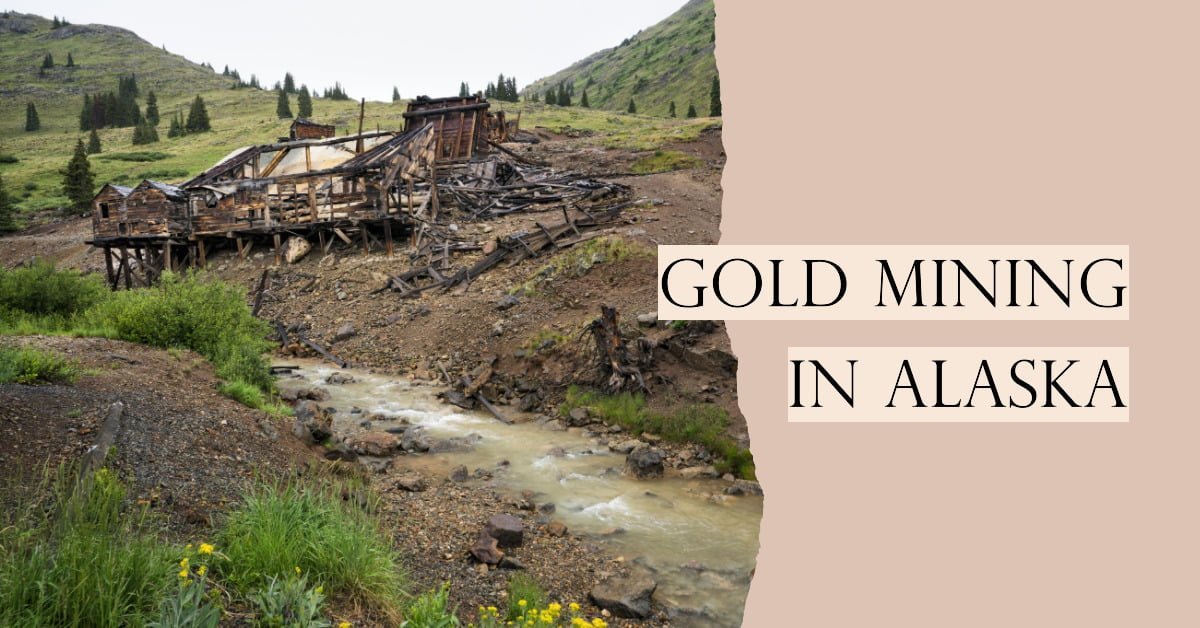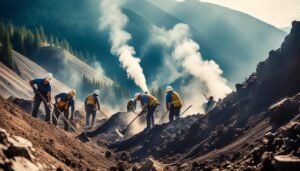Did you know that Alaska was once the center of a frenzy that captured the imaginations of people worldwide?
The Alaska Gold Rushes, including the Klondike Gold Rush, were an exhilarating chapter in history. Prospectors from all corners flocked to Alaska after gold was discovered, transforming towns like Fairbanks, Juneau, and Haines into bustling hubs of activity.
Creeks yielded precious nuggets while rivers ran with potential wealth. The stampede for riches even led to the construction of railroads and visitor centers for eager stampeders. With abundant resources waiting to be uncovered in its placers, Alaska became a symbol of hope and opportunity in the wild west and north.
Get ready to delve into this captivating journey through time as we explore the fascinating world of gold mining in Alaska, including the Chilkoot Trail, lode mines, Chilkoot Pass, and lode deposits.
Key Takeaways
🌍 Alaska’s Gold Rush Era: Alaska experienced major gold rushes, which saw towns like Fairbanks, Juneau, and Haines transform into hubs of activity due to discoveries in creeks and rivers.
📅 Key Gold Rush Events: Notable events include the discovery on Douglas Island (1880), the Klondike Gold Rush (1896), Nome Gold Rush (1899), Fairbanks Gold Rush (1902), and the establishment of Denali National Park (1917).
💰 Economic Impact: Gold mining significantly shaped Alaska’s economy, creating jobs, generating revenue, and boosting related sectors like transportation and tourism.
🏞️ Exploring Historic Gold Mines: Key historic sites include Independence Mine State Historical Park, Kennecott Mine National Historic Landmark, and Nome District State Historical Park.
🏗️ Development Impacts: Gold mining led to infrastructure growth, establishment of towns like Juneau and Fairbanks, and technological innovations. However, environmental concerns arose due to mining processes.
Key Dates and Events of the Alaska Gold Rushes
Discovery on Douglas Island (1880)
The first major gold rush in Alaska can be traced back to 1880 when gold was discovered on Douglas Island, near Juneau. This pivotal moment marked the beginning of a transformative era for the region and its mining districts. Prospectors from all corners of the globe flocked to Alaska in search of fortune, igniting a frenzy that would forever shape its history. The Chilkoot Trail became a popular route for exploration during this time.
Klondike Gold Rush (1896)
One of the most renowned events in gold mining history, the Klondike Gold Rush began in 1896 when gold was found along Bonanza Creek in Yukon Territory, Canada. Although not directly located within Alaska’s borders, this discovery had a profound impact on the entire region, including the Chilkoot Trail and Chilkoot Pass. News spread like wildfire, luring thousands of eager prospectors who ventured into Alaska en route to the Klondike region and the lode mines in Juneau.
Establishment of U.S. Bureau of Mines (1902)
Recognizing the need for government regulation and safety during the Alaskan gold rushes, Congress established the U.S. Bureau of Mines in 1902 to oversee mining activities and promote safety measures. This organization played a vital role in protecting miners and the environment from potential hazards associated with unregulated exploration of lode deposits.
As prospectors poured into Juneau, Alaska, each seeking their share of golden treasures hidden beneath its rugged terrain, exploration of the Chilkoot Trail and mining districts unfolded. Numerous other significant dates and events occurred.
- Nome Gold Rush (1899): Following rumors of vast gold deposits along Nome’s beaches, hordes of hopeful miners descended upon this remote coastal town. The discovery led to an unprecedented influx of people and resources as they braved harsh weather conditions and treacherous journeys across frozen waters.
- Fairbanks Gold Rush (1902): The discovery of gold near Fairbanks sparked another wave of excitement as miners rushed to stake their claims within this mineral-rich region. The establishment of Fairbanks as a mining hub further solidified Alaska’s reputation as a gold-rich territory.
- Iditarod Gold Rush (1908): The Iditarod Trail, known for its grueling dog sled races today, was once the path to fortune for many prospectors during the gold rush era. This remote trail witnessed an influx of miners seeking their fortunes in the vast wilderness of western Alaska.
- Creation of Denali National Park (1917): As the gold rushes gradually declined, efforts were made to preserve Alaska’s natural beauty and protect its wildlife. Denali National Park was established in 1917, encompassing the majestic Mount McKinley (now known as Denali) and serving as a testament to Alaska’s rich history.
These key dates and events provide a glimpse into the captivating saga of gold mining in Alaska, including the discovery of silver lode at Chilkoot and Independence Mine. From the initial discovery on Douglas Island to the establishment of regulatory bodies, each milestone played a crucial role in shaping not only Alaska’s economy but also its cultural identity.
Significance of Gold Mining in Alaska’s Economy
Gold mining, along with silver production, has played a crucial role in shaping Alaska’s economy since its early days. Today, it remains an important industry contributing to jobs and revenue for the state. The economic impact extends beyond mining itself, as supporting industries such as transportation and tourism also benefit from the extraction of gold from lode and placer deposits.
Gold mining in Alaska has a rich history of lode and placer deposits, dating back to the late 1800s when gold and silver were discovered in the Klondike region. This discovery sparked a gold rush, attracting thousands of prospectors from all over the world to the north. The influx of people seeking their fortune led to the establishment of towns and infrastructure, laying the foundation for Alaska’s economic development.
One of the key reasons why gold mining is significant to Alaska’s economy is its contribution to job creation. The industry provides employment opportunities for a wide range of workers, including miners, geologists, engineers, and support staff. These jobs not only offer competitive wages but also provide stability for individuals and families living in remote areas where other employment options may be limited. In addition, gold mining plays a crucial role in the production of silver in the region, particularly in the lode deposits found along Silver Creek.
In addition to job creation, gold mining in the production lode district generates substantial revenue for both the state government and local communities in the area. Through taxes, royalties, and fees imposed on mining operations, Alaska receives a significant portion of its income from this sector. This revenue helps fund essential public services such as education, healthcare, infrastructure development, and environmental conservation efforts.
Moreover, the economic benefits derived from gold mining extend beyond direct contributions from the industry itself. Supporting sectors like transportation play a vital role in facilitating the movement of equipment, supplies, and personnel to remote mining sites across vast Alaskan landscapes. This creates additional employment opportunities within transportation companies while also stimulating growth in related industries such as logistics and fuel supply. The production of gold in the lode and placer districts contributes to these economic benefits.
Furthermore, gold mining in the area attracts tourists who are eager to explore Alaska’s rich history and witness firsthand the extraction of this precious metal from the earth. Visitors often engage in guided tours or visit museums dedicated to showcasing artifacts and stories from the gold rush era. This influx of tourists contributes to the local economy through spending on accommodations, dining, transportation, and recreational activities in the lode production creek area.
To summarize, gold mining plays a crucial role in Alaska’s economy. Its historical roots in the district have shaped the state’s development, while its present-day production continues to provide jobs and generate revenue. The industry’s impact extends beyond mining itself, benefiting supporting sectors like transportation and tourism in the area. As long as there are valuable lode deposits to be found in Alaska’s rugged terrain, gold mining will remain a vital economic driver for the state.
Exploration of Historic Gold Mines in Alaska
Alaska has a rich history of gold mining. Visitors to the state have the opportunity to explore various historic gold mines, each with its own unique story and remnants of the past. From Independence Mine State Historical Park near Palmer to Kennecott Mine National Historic Landmark and Nome District State Historical Park, there is no shortage of fascinating sites for those interested in delving into Alaska’s lode, placer, and creek gold mining legacy.
Independence Mine State Historical Park
One of the must-visit destinations for gold mining enthusiasts is Independence Mine State Historical Park. Located near Palmer in the district, this park offers a firsthand experience of what life was like during the peak of gold mining operations in Alaska. The mine operated from 1938 until 1951, extracting both lode gold and placer deposits. Today, visitors can explore the old mine buildings in the area, walk along trails that once bustled with mining activity, and even try their luck at panning for gold in nearby streams and creeks.
Kennecott Mine National Historic Landmark
For a glimpse into one of America’s richest copper mines in the Kennecott mining district, with traces of gold too, look no further than Kennecott Mine National Historic Landmark. Situated in Wrangell-St. Elias National Park and Preserve, this site showcases the immense scale of a bygone era in this historic mining area.
The discovery of massive copper deposits led to a boomtown known as Kennecott springing up around the lode in the early 20th century. While primarily focused on copper extraction, there were significant amounts of gold found as well in this mining district. Exploring this landmark allows visitors to step back in time and witness firsthand the grandeur and challenges faced by miners who worked deep underground in this creek-rich area.
Nome District State Historical Park
The Nome District State Historical Park provides an intriguing glimpse into one of Alaska’s most significant placer mining areas. During the famous Klondike Gold Rush at the end of the 19th century, Nome became a hub of gold mining activity.
Today, remnants from that era still dot the landscape, serving as a reminder of the hardships and fortunes made during those times. Visitors can explore old dredges, abandoned cabins, and various artifacts left behind by prospectors who flocked to this region in search of their own gold strike. The park offers a unique opportunity to witness the lode, creek, and river where miners once found ounces of gold.
Impact of Gold Mining on Alaska’s Development
The impact of gold mining on Alaska’s development has been profound, with the influx of miners during the gold rushes leading to increased infrastructure development across remote regions. Towns like Juneau and Fairbanks owe their growth to early mining activities, while construction projects such as railroads were initiated to support transportation needs for both miners and supplies. The discovery of gold lodes and creeks in the district played a crucial role in attracting miners to these areas, with the river serving as a vital resource for mining operations.
The discovery of gold in Alaska sparked a rush of prospectors from all over the world, transforming previously untouched wilderness into bustling mining camps. The sudden population boom necessitated the creation of essential infrastructure to support the growing needs of these communities. Roads were built through rugged terrains, connecting isolated areas and facilitating transportation of people and supplies. The gold rush brought a surge of activity to the creek, lode, district, and river.
In addition to roads, railroads played a crucial role in Alaska’s development due to gold mining. These iron arteries not only enabled efficient movement of goods but also facilitated access to remote locations that were otherwise difficult to reach, such as lodes and creeks. The White Pass and Yukon Route Railroad, constructed during the Klondike Gold Rush, became an important lifeline for miners looking to transport their valuable findings out of Alaska’s rivers and areas.
The rapid growth experienced by towns like Juneau and Fairbanks can be directly attributed to the success of early gold mining operations in the district. As more gold was discovered in these areas, people flocked in search of fortune, resulting in the establishment of permanent settlements. These towns quickly evolved from makeshift camps into thriving urban centers with businesses catering to the needs and desires of miners in the creek, lode, and placer.
With the development brought about by gold mining in the lode and placer districts, came other essential amenities that improved living conditions for residents. Schools, hospitals, general stores, saloons, and theaters sprang up as communities along the creek grew larger and more established. The economic prosperity generated by gold mining allowed for investments in public services that greatly contributed to improving quality of life in the district.
Moreover, gold mining in Alaska spurred innovation in technology and engineering practices as miners sought more efficient ways to extract gold from lode deposits. Hydraulic mining techniques, dredging operations, and the use of heavy machinery were introduced to Alaska’s rivers and creeks, revolutionizing the industry and paving the way for future advancements. These advancements allowed miners to extract larger quantities of gold ounces.
It is important to recognize that while gold mining, including lode and placer mining, played a significant role in Alaska’s development, it also had environmental consequences. The extraction process often involved altering landscapes near creeks and rivers and disrupting ecosystems. However, over time, efforts have been made to balance economic growth with sustainable practices to mitigate these impacts.
Notable Discoveries in Alaska’s Gold Mining History
The history of gold mining in Alaska is filled with remarkable discoveries in lode and placer deposits that shaped the state’s development and attracted prospectors from all over. Let’s delve into some of the most notable gold discoveries along the creek and in the district that left an indelible mark on Alaska’s rich mining history.
The Anvil Creek Discovery: Birth of Nome
One of the pivotal moments in Alaska’s gold mining history occurred in 1898 when gold was discovered on Anvil Creek in the Nome district. This discovery led to the establishment of Nome, a bustling town that quickly became one of the major centers for gold mining, with prospectors flocking to strike it rich and find lode ounces along the river.
The allure of gold drew people from far and wide to the Nome mining district, transforming the town into a vibrant hub where dreams of striking it rich were born and shattered. Miners set up camps along the Anvil Creek, digging deep into its gravel beds in search of lode deposits and placer gold nuggets. The Anvil Creek discovery not only brought wealth but also established Nome as an enduring symbol of Alaska’s gold rush era.
The Fairbanks Gold Rush: Tales from Tanana River
In 1902, another significant chapter unfolded with the discovery of gold in the Fairbanks mining district on the banks of the Tanana River. This event triggered what came to be known as the Fairbanks Gold Rush, attracting a wave of fortune seekers eager to stake their claims along this mighty waterway and find placer gold worth ounces.
News spread like wildfire, drawing prospectors to the Fairbanks mining district who ventured into uncharted territories to uncover nature’s hidden treasures. As they panned for gold along riverbanks and sifted through gravels in the creek, dreams of finding placer gold took shape amidst hardships and perseverance. Fairbanks emerged as a thriving city built upon these golden aspirations, leaving an enduring legacy etched within Alaska’s heartland. The prospectors’ efforts yielded countless ounces of gold.
The Porcupine Gold Rush: A Borderland Lure
In 1898, yet another glittering opportunity arose when prospectors were enticed to the mining district near the Yukon-Alaska border by the Porcupine Gold Rush. This discovery ignited a frenzy as hopeful miners crossed borders, navigating rugged terrains in search of their golden fortunes in the creek and river placer.
The allure of striking it rich in the placer district was irresistible, leading to a surge in population as camps sprouted along the Porcupine Creek. Prospectors braved harsh conditions, battling frigid temperatures and challenging landscapes to unearth ounces of the precious metal that lay beneath the earth’s surface. The Porcupine Gold Rush became an emblem of grit and determination, forever etching its place in Alaska’s gold mining chronicles.
As we explore Alaska’s gold mining history, these notable discoveries along the creek, in the district, and by the river stand out as testament to the resilience and adventurous spirit of those who sought their fortunes amidst untamed wilderness. Nome, Fairbanks, and the Yukon-Alaska border area are just a few examples of how placer gold sparked dreams and shaped communities that endure to this day.
In every tale lies a reminder that Alaska’s rich history is deeply intertwined with its golden legacy. Whether it be the mining district, the creek, the river, or the ounces of gold, each element plays a vital role in shaping the state’s past.
Recreational Gold Mining in Alaska: Adventure and Legacy
Recreational gold mining in Alaska’s placer-rich river districts remains a popular activity for both locals and tourists. Crow Creek Mine, near Anchorage, offers an adventurous outdoor experience where visitors can delve into the historic gold mining history and try their luck at panning for ounces of gold.
At Crow Creek Mine, visitors can immerse themselves in the ambiance of an authentic gold mining operation in the placer district. The mine provides all the necessary equipment, including pans and shovels, allowing guests to jump right into the action of sifting through gravel and sediment from the river. Anticipation builds with every glimmer of yellow metal that catches their eye, as they search for ounces of gold. It’s a hands-on experience that brings people closer to nature and connects them with Alaska’s past.
The allure of recreational gold mining lies not only in the excitement of finding precious flakes or nuggets in a creek or river, but also in preserving the legacy of Alaska’s rich placer mining history. Many individuals find joy and fulfillment through this activity as they contribute to keeping alive the stories of those who came before them, becoming part of a long line of prospectors who have ventured into these wild landscapes seeking fortune in a mine.
Apart from Crow Creek Mine, there are other designated areas in the placer district of Alaska where recreational gold mining is permitted. For example, Crooked Creek Trail in Hatcher Pass Public Use Area offers enthusiasts an opportunity to explore its scenic surroundings while trying their hand at panning for gold in the river. Willow Creek is another popular location known for its abundant mineral deposits and picturesque setting, with the potential to yield significant ounces of gold.
Alaska’s state parks also provide access to recreational gold mining areas in the creek, placer, and river districts that cater to both beginners and experienced miners alike. With proper permits and adherence to regulations, visitors can enjoy this unique outdoor activity while appreciating the natural beauty that surrounds them.
Engaging in recreational gold mining not only offers adventure and the chance of striking it rich, but also provides an opportunity to learn about Alaska’s fascinating history. As visitors pan for gold in the creek, they can imagine the hardships faced by early prospectors who braved harsh conditions in their quest for wealth. It is a hands-on history lesson that brings the past to life, as they search for placer gold in the river and hope to find valuable ounces.
The Enduring Richness of Alaska’s Gold Mining History
Alaska’s gold mining history is a captivating tale of perseverance, hardship, and fortune. It has left an indelible mark on the state’s culture, identity, and economy. Today, the remnants of historic mines in the district stand as poignant reminders of this enduring richness. The creek and river yielded ounces of gold, contributing to Alaska’s prosperity.
The allure of striking it rich with gold nuggets drew countless prospectors to the mining district of Alaska during the late 19th century. These intrepid individuals braved treacherous conditions in their quest for rock gold. The discovery of vast deposits fueled a boom in gold production that shaped the destiny of Alaska’s mining district.
Both placer gold and hard rock gold played crucial roles in Alaska’s mining industry. Placer mining involved extracting alluvial deposits from rivers, streams, and creeks using simple tools such as pans and sluice boxes. This method allowed prospectors to recover significant amounts of gold from areas like the Yukon River basin. The district was rich in both placer and hard rock mines, yielding ounces of gold.
On the other hand, hard rock mining required more advanced techniques to extract gold from lode deposits embedded within solid rock formations. Miners faced immense challenges while tunneling into mountainsides or drilling deep underground shafts to access these valuable veins. Despite the hardships, their perseverance paid off as they unearthed substantial quantities of precious metal from river, creek, placer, and district.
During the gold rush era in Alaska, not only gold was found but also silver, copper, and other minerals. The Bering Sea region was famous for its copper mines, while the Kenai Peninsula yielded large amounts of silver. These diverse mineral discoveries further enriched Alaska’s mining legacy in the creek district. Placer mining became a significant part of Alaska’s mineral resources.
The impact of gold mining on Alaska’s Creek district was not limited to its economic significance but extended to shaping its history as well. Entire towns sprang up around prosperous placer mines, creating vibrant communities that thrived on the wealth generated by these operations. Stories abound about how these settlements were transformed overnight due to a single troy ounce nugget or a successful strike.
While many historic mines in Alaska’s placer district have long been abandoned, their remnants serve as tangible links to the state’s golden past. Visitors can explore the decaying structures and machinery that once buzzed with activity at the creek, gaining a glimpse into the lives of those who toiled in pursuit of wealth. These ghostly reminders evoke a sense of wonder and appreciation for the pioneers who shaped Alaska’s mining heritage.
Concluding the Rich History of Gold Mining in Alaska
Alaska’s gold mining history is a treasure trove of remarkable events, economic significance, and enduring legacies. From the key dates and events of the gold rushes to the exploration of historic mines in the district, this rich history has left an indelible mark on Alaska’s development. The discovery of gold in the creek led to an influx of miners, with the hope of finding ounces of placer gold.
The Alaska Gold Rushes saw thousands flocking to the creek region in search of placer fortune during the late 19th and early 20th centuries. These rushes not only shaped Alaska’s landscape but also ignited economic booms that reverberated throughout the district. The significance of gold mining in Alaska’s economy cannot be overstated, as it provided jobs, infrastructure development, and a source of wealth for countless individuals, yielding ounces of precious metal.
Exploration of historic gold mines in the Alaska mining district has allowed us to delve into the past and uncover stories of perseverance and adventure. These mines, located near a creek, serve as reminders of the challenges faced by early prospectors who braved harsh conditions in their quest for riches. They stand as testaments to human ingenuity and determination, producing significant ounces of placer gold.
Gold mining played a pivotal role in shaping Alaska’s development. It spurred population growth, led to the establishment of towns and cities, and fueled infrastructure projects such as railways and roads. The impact was far-reaching, transforming remote wilderness into thriving communities that continue to thrive today. The discovery of gold in the creek and placer district resulted in the extraction of valuable ounces.
Throughout its history, Alaska witnessed notable discoveries in its mining district that captivated imaginations worldwide. From massive nuggets to record-breaking yields of ounces, these findings further solidified Alaska’s reputation as a land abundant with golden opportunities. They continue to inspire dreamers who seek their own fortunes amidst this storied backdrop of placer creek.
Recreational gold mining in present-day Alaska offers locals and visitors the chance to strike gold in the placer creek. This adventurous pursuit connects people with their heritage and the thrill of finding ounces of precious metal. It carries on a legacy of dreams, resilience, and shared experiences in the mine.
As we conclude our journey through Alaska’s rich gold mining history, it is evident that this legacy of placer mining in the district endures. Its impact on the state’s economy, culture, and identity remains palpable. The stories of those who sought their fortunes in Alaska’s gold mines and panned for ounces of gold in the creek continue to inspire and captivate.
If you’re drawn to the allure of gold mining in Alaska, consider embarking on your own adventure. Whether it’s exploring historic sites, trying your hand at recreational mining in a placer mine, or simply immersing yourself in the fascinating tales of the past, there are countless ways to engage with this enduring legacy.
Discover hidden gold nuggets in the creek and uncover ounces of precious metal.








